FIRST CAME AN UNSUCCESSFUL scouting trip, then several days poring over Google Earth, and now I’ve finally nailed down what I think is the location of a mythical place called “Hoodooville.” The winter weekend is just sunny enough to dry the tops of muddy roads, so I pile my two boys into the back seat of the car and we head to the badlands of northwestern New Mexico. I turn off NM 550 somewhere between the Navajo communities of Nageezi and Counselor and onto a narrow dirt road. Weaving through a sagebrush sea dotted with oil-well pads, the road dips over the edge of the plateau and the Lybrook Badlands pop into view. Before us, miles of rolling clay hills, spires, colorful mesas, and (if my research is correct) hoodoos stretch to the horizon.
Gnarled junipers and stunted ponderosa pines grow from sandstone cliffs; some of these trees are hundreds of years old. At a pull-off, an earthy rainbow of colored rocks dots the ground under my feet. Upon closer inspection, I realize the larger rocks are actually chips of petrified wood—thousands of pieces spread out in the drainage before me. My boys each slip one piece into their pocket (a small amount of collecting is allowed on BLM land).
Those trees stood millions of years ago when waves of an inland sea lapped at shores covered in coastal swamps. As the plants, dinosaurs, and other animals died they turned into mud and then hardened into rock, before turning eventually into oil and natural gas. Today, the “play,” as the oil companies call it, for these fossil fuels is at full throttle across the Greater Chaco area. We pass a large well pad where a dozen men work swiftly to install pipes, tanks, compressors, and drills. Farther down the road, a backhoe scrapes the earth to form a catchment pond for fracking wastewater. We reach the end of a road where a pump jack thrums ceaselessly to extract the black gold, the Texas tea, the dinosaur remains that power our world and my SUV.
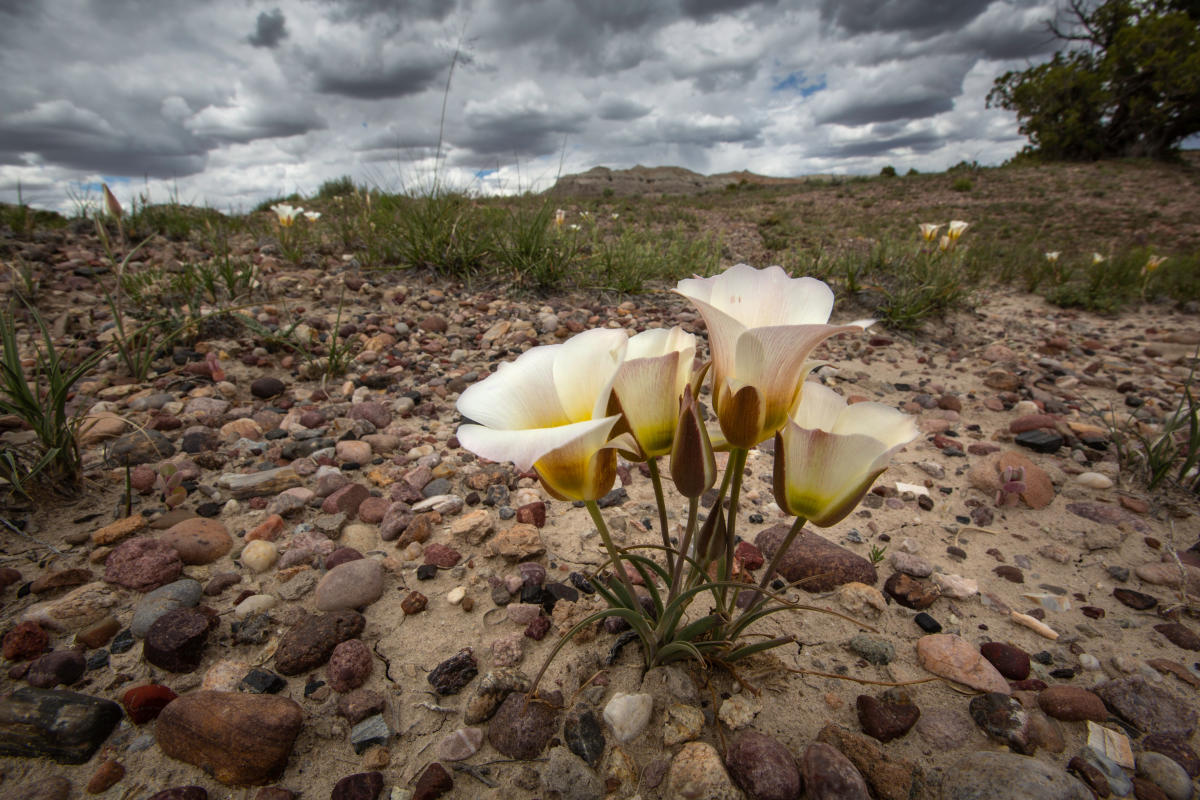 Sego lilies break through difficult soil.
Sego lilies break through difficult soil.
We park next to the pump jack and follow the tracks of a mule deer up a rise. We scare a large bird from its perch. At first I think it’s a red-tailed hawk, but as it flies into better light, I see golden flecks on black feathers across the large wingspan of a golden eagle. They are known to frequent the Lybrook Badlands before nesting season, when they spread out across the San Juan Basin looking for scarce winter food.
Walking along the crest of clay hills, I spy movement in the canyon below. A great horned owl glides from its perch in a twisted juniper tree and lands in the open to take a good look at us. I stop in my tracks and stare back. For several moments we contemplate each other, until a movement from the boys sends it flying down canyon and into hiding.
The crusted mud, dried and cracked by the sun like elephant skin, crunches under our hiking boots. Our footprints leave loosened soil as a reminder of how delicate this land is. Maybe it’s a good thing the place is hard to find, I think. Adding streams of hikers to the existing road building, oil drilling, and off-road driving would impose another erosive force, speeding up what nature takes millennia to accomplish.
From the top of the hills, I now see what we’ve come for: About a half mile in the distance sit dozens of hoodoos, arranged in a U-shaped band at the upper end of a box canyon. Carefully, we pick our way toward them.
Blocked by distance and layers of clay, the industrial noise fades. In the relative silence, we wander under and around towering formations, marveling at their descriptive names. The Orb is a perfectly round orange rock that sits atop a 20-foot-tall pedestal. The Couple is two spires facing each other in an eternal embrace. My boys crow with delight when we find the Flying Saucer—a brown cap rock that looks exactly like a UFO that crash-landed sideways into the white sandstone. This small area rivals or perhaps surpasses anything I’ve seen in the better-known Bisti/De-Na-Zin Wilderness Area.
We go deeper, exploring more hoodoos and losing track of time. The late afternoon sun saturates the mesas on the eastern horizon with a golden light. The badlands seem to stand taller, showing off their best. As twilight darkens the sky, my boys complain about having to leave so soon, but I pacify them with promises and more promises that, yes, we will return.
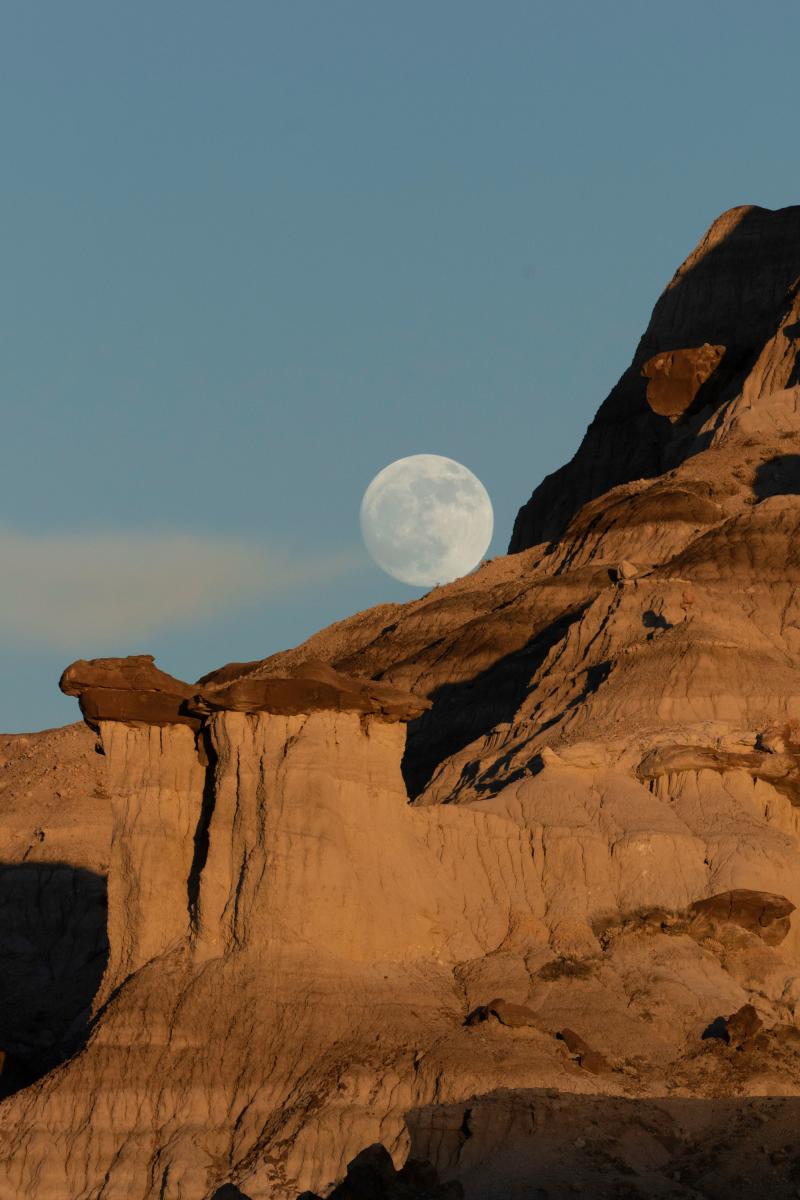
The moon poses above a barren cliff.
THE NEXT TIME I VISIT THE BADLANDS, I’m on a mission to see a man about a cactus. As a naturalist and lifelong wildflower enthusiast, I’ve traveled all across the state to see New Mexico’s native plants. The same geologic forces that built these badlands also laid the foundation of a unique ecosystem that harbors wildlife and rare plants found nowhere else in the world. On a late spring day, I’m excited to finally see the rare treasures that the badlands hold.
I’ve arranged to spend the day in Lybrook with John Kendall, the wildlife biologist in charge of threatened and endangered species at the BLM’s Farmington Field Office. After quick introductions, I follow him through a gate to a large well pad where roaring compressors surround eight oil towers. We walk away from the noise and ascend gray-green hills sculpted by water and wind. We keep our eyes to the ground, searching for flowers, when a flash of color catches my eye. I’ve found our treasure: a pinkish-purple blossom atop a cactus no bigger than a baseball, with rows of hooked spines. The Clover’s cactus (Sclerocactus cloverae) grows only in a relatively narrow 100-mile strip in the San Juan Basin Badlands. You’ll find it nowhere else in the world.
It found its perfect growing conditions in the Nacimiento Formation, which sits atop large oil and gas deposits in the Mancos Shale, a layer formed in the marine environments of the inland sea that covered much of New Mexico up to 95 million years ago. For years, these oil and natural gas pockets were locked in ancient mudrock. With recent advances in horizontal fracking technology using high-pressure sand, water, and chemicals, companies can break apart the mudrock to access the fossil fuels. The San Juan Basin, an area where productivity had been in decline, is now expected to see the density of its oil wells double.
When new well or pipeline projects are proposed where a rare plant grows (in this case, the Clover’s is a BLM “sensitive species”), state laws do not protect them from destruction within their natural habitat; the laws prohibit only unauthorized collection and transport of species. Under current BLM policy, when a project is proposed where Clover’s cactus grows, a developer can voluntarily move the project, transplant the plants to other suitable habitat, or plow the plants under. Based on 2019 BLM statistics, most of the time plants get plowed under; sometimes they get transplanted, and almost never is a project moved.
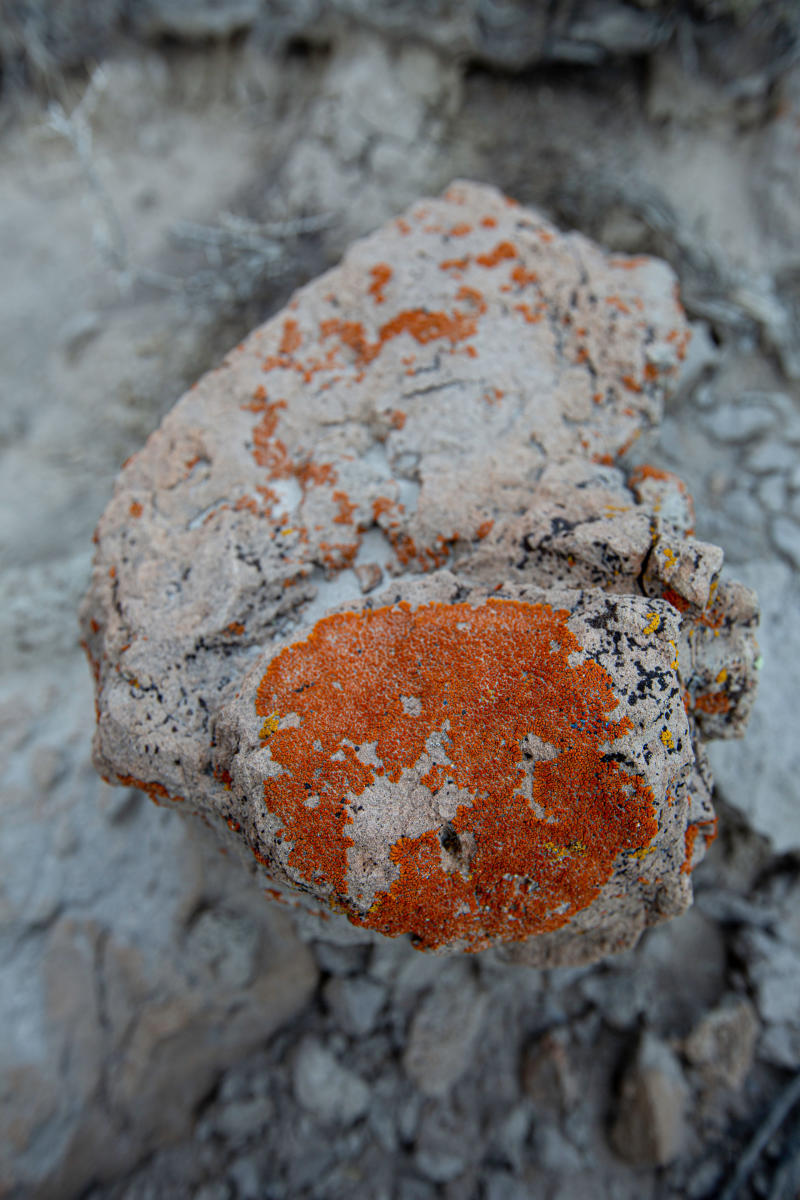
Lichens thrive on a rock.
Working out of the Farmington Field Office for 16 years to conserve rare and endangered species, Kendall says, “Mainly I’m fighting to protect habitat. The soil in these badlands is unstable, highly erodible, and easily impacted. Once these soils are disturbed, nothing grows in them.” Plants keep soil in place, so preserving this cactus’s habitat benefits more than just plants. “All of this disturbed soil runs into the San Juan River, where we have two endangered fish,” he says. Those fish cannot breed in waters oversaturated with sediment. Fish are a major food source for many birds, including some raptors, which in turn help control rabbit populations.
After years of drought and lack of control from predators, the rabbit population boomed from 2013 to 2015. With a diminishing food base, Kendall believes the rabbits and other small mammals turned to the cactus to supplement their food supply, thus devastating the cactus population in the Lybrook area. It can take decades for the cactus to come back in these fragile soils. “I haven’t observed any rebound in the population numbers since 2015,” Kendall says.
He monitors several other sensitive or rare species in the badlands: Aztec gilia and Mancos milkvetch, both wildflowers; nesting burrowing owls, Gunnison’s prairie dogs, golden and bald eagles, ferruginous hawks, and peregrine falcons. Bobcats, coyotes, herds of elk, and an occasional black bear also walk through.
At the end of my day with Kendall, I come to the end of a road. I pass a well pad and walk up a water drainage into a sandstone box canyon yet untouched by development. Winter rains have brought a flurry of wildflowers along the bottoms of the cliffs. Sego lilies push up between cobblestones. Purple and white lupines mix with yellow western wallflowers to form a wildflower meadow among cap rocks. White asters and evening primroses, purple larkspur, and several varieties of penstemon bloom profusely in washes. In this remaining healthy patch of the ecosystem, I am awestruck by the ability of these flowers to thrive in such a stark landscape.
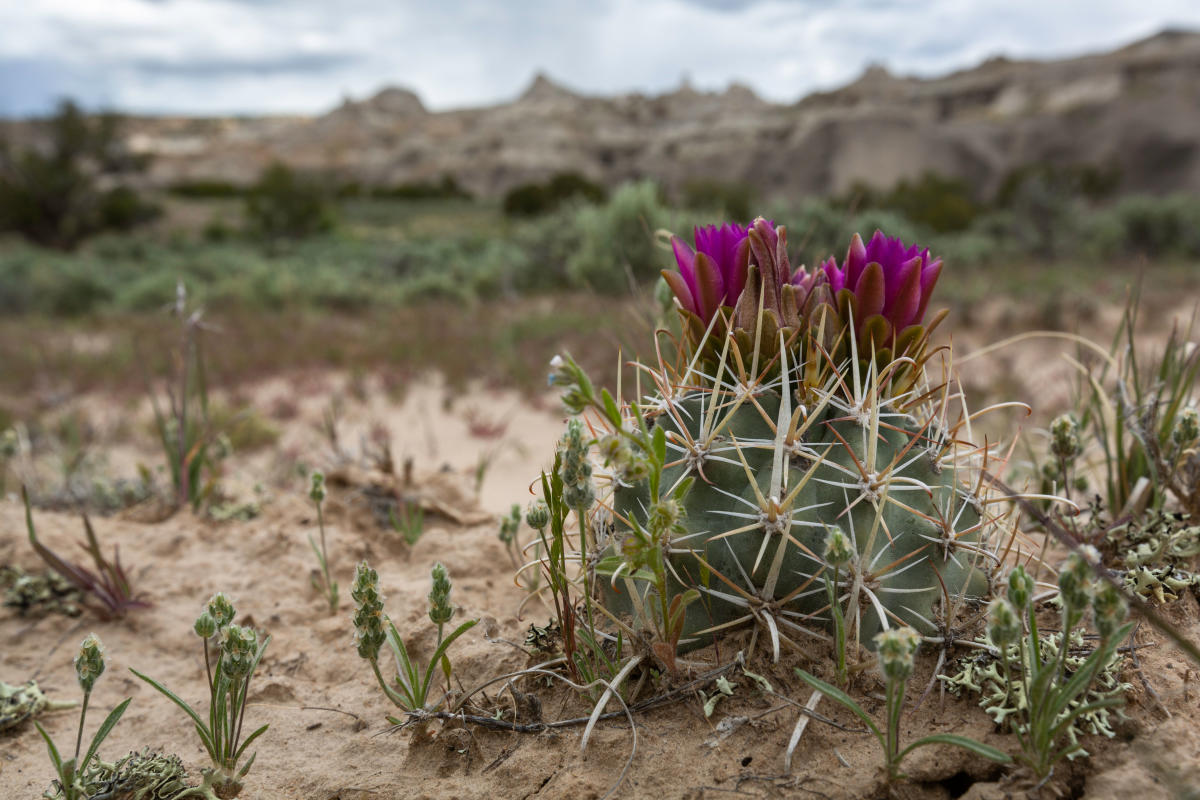 Clover’s cactus blooms.
Clover’s cactus blooms.
THE NEXT MORNING, an hour before dawn, I drag myself out of my hotel bed in Bloomfield to drive 20 miles south to the Angel Peak Scenic Area to catch the sunrise. I pull up to an overlook on the rim of the Kutz Canyon Badlands. A prominent landmark in the San Juan Basin, Angel Peak rises to almost 7,000 feet. From certain angles, it looks like its name—an angel with outstretched wings. The snowcapped San Juan Mountains make an impressive backdrop to the west. The sandstone peak sits atop chiseled fingers of deep canyons banded with the Nacimiento Formation’s silt, sand, and mudstone. Fossilized remains of mammals, fish, lizards, and crocodiles lie frozen among the layers; some can be found eroding out of the formations below.
From the overlook I watch a spectacular show of color as the sun breaches the horizon. Morning light moves across the banded layers of rocks, highlighting one formation after another and underscoring the magic of the eroded terrain.
I descend a sketchy road cut by oil and gas companies on a narrow mesa to access the canyon below. I white-knuckle the steering wheel as my SUV crawls over a steep section of exposed sandstone boulders. The road drops several hundred feet on either side of me. I wonder how the oil and gas workers manage the route in their trucks. With relief, I reach the bottom, where a network of roads radiate like the tentacles of a massive octopus into every canyon of this 10,000-acre badland.
I park next to an ear-piercing oil rig and mount my solar-powered electric mountain bike. For several miles I follow yellow flags and PVC signs that mark the natural gas pipeline buried underground. Other than the deep ruts made by oil trucks, the sandy and dried-mud road makes for easy biking. I spot mule deer and coyote tracks in washes, watch flocks of songbirds fly from their perches in juniper trees, and admire the changing colors of the mud domes and sandstone castles that tower overhead. I pause to lift my binoculars and scan the cliffs for golden eagles, finding one high above on a wing of Angel Peak. He scans up to two miles into the distance with his keen eyes, watching for small mammals to scurry into the open. The land he surveys belongs to him, to rare wildflowers, to oil and gas interests, to the federal government, to Native peoples, to hikers and bikers and ATVers, to future generations, to all of us, and to none of us.
The road systems cut by the oil and gas industry are a double-edged sword. They allow us to enter the heart of these badlands to explore an area that would take days to cover on foot or horseback in a roadless wilderness. Here, we can experience the profound peace of wilderness thanks to the convenience of a car. But that convenience comes at a cost to this place and the species that call it home.
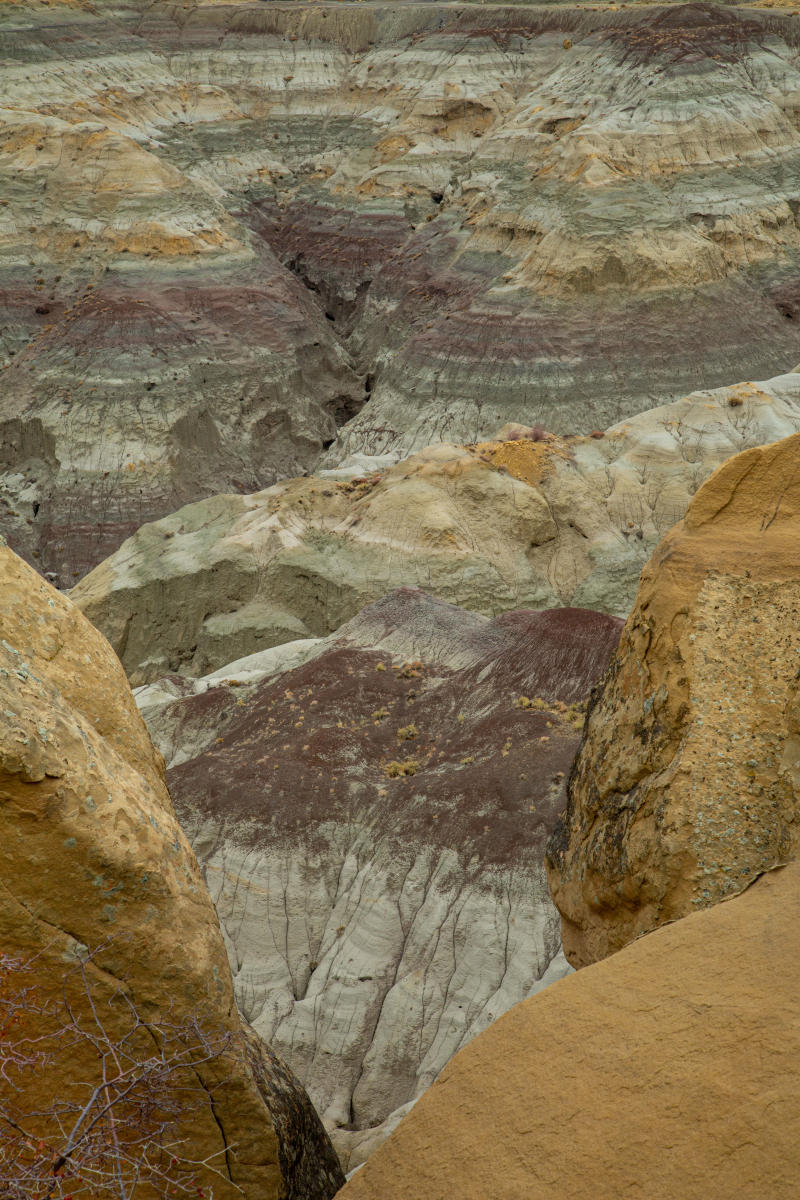
Colored bands speak to different eras of geologic formation.
On my way home, I make a final stop at the Black Place, just off NM 550. The mud domes sculpted by wind and rain look like the gray folds and wrinkles of leathery skin. Artist Georgia O’Keeffe aptly described it as “a mile of elephants.” She visited often over the course of 14 years, camping out for several days at a time to catch sunrises and sunsets. The place touched something deep inside her and inspired an outpouring of work almost unmatched in her career. Her love for it is palpable in the paintings and sketches, some of which are now part of the New York Metropolitan Museum’s collection and that of the Georgia O’Keeffe Museum, in Santa Fe.
I wonder how she would paint the story of this place if she stood here with me today. Among her sensuous hills, would she paint in the massive army-green towers labeled CRUDE OIL that partially block the view? Would she leave those out in favor of the more pristine and abstract depiction of nature she was famous for? Would she simply leave?
Western writer Terry Tempest Williams wrote in her book Finding Beauty in a Broken World, “Beauty is not a luxury but a strategy for survival.” In the badlands, geological transformation has gifted us with ground that delivers rare wildflowers whose strong roots hold a larger world together. As I return to my car, I tread lightly on this broken but beautiful home.


